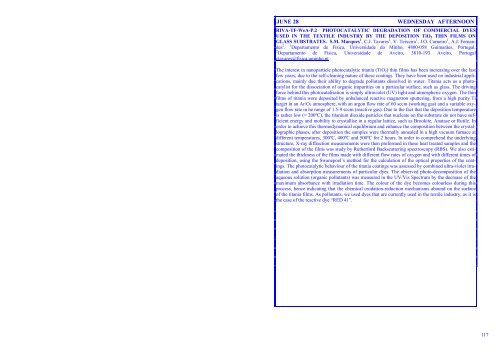Wüest M. 51 Wykes M. 82 Yamaguchi M. 17 Ybarra G. 129 Yubero F ...
Wüest M. 51 Wykes M. 82 Yamaguchi M. 17 Ybarra G. 129 Yubero F ...
Wüest M. 51 Wykes M. 82 Yamaguchi M. 17 Ybarra G. 129 Yubero F ...
You also want an ePaper? Increase the reach of your titles
YUMPU automatically turns print PDFs into web optimized ePapers that Google loves.
JUNE 28 WEDNESDAY AFTERNOON<br />
RIVA-TF-WeA-P.2 PHOTOCATALYTIC DEGRADATION OF COMMERCIAL DYES<br />
USED IN THE TEXTILE INDUSTRY BY THE DEPOSITION TiO 2 THIN FILMS ON<br />
GLASS SUBSTRATES. S.M. Marques 1 , C.J. Tavares 1 , V. Teixeira 1 , J.O. Carneiro 1 , A.J. Fernandes<br />
2 .<br />
1 Departamento de Física, Universidade do Minho, 4800-058 Guimarães, Portugal.<br />
2 Departamento de Física, Universidade de Aveiro, 3810-193 Aveiro, Portugal<br />
ctavares@fisica.uminho.pt<br />
The interest in nanoparticle photocatalytic titania (TiO 2 ) thin films has been increasing over the last<br />
few years, due to the self-cleaning nature of these coatings. They have been used on industrial applications,<br />
mainly due their ability to degrade pollutants dissolved in water. Titania acts as a photocatylist<br />
for the dissociation of organic impurities on a particular surface, such as glass. The driving<br />
force behind this photocatalisation is simply ultraviolet (UV) light and atmospheric oxygen. The thin<br />
films of titania were deposited by unbalanced reactive magnetron sputtering, from a high purity Ti<br />
target in an Ar/O 2 atmosphere, with an argon flow rate of 60 sccm (working gas) and a variable oxygen<br />
flow rate in he range of 1.5-9 sccm (reactive gas). Due to the fact that the deposition temperature<br />
is rather low (≈ 200ºC), the titanium dioxide particles that nucleate on the substrate do not have sufficient<br />
energy and mobility to crystallise in a regular lattice, such as Brookite, Anatase or Rutile. In<br />
order to achieve this thermodynamical equilibrium and enhance the composition between the crystallographic<br />
phases, after deposition the samples were thermally annealed in a high vacuum furnace at<br />
different temperatures, 300ºC, 400ºC and 500ºC for 2 hours. In order to comprehend the underlying<br />
structure, X-ray diffraction measurements were then preformed in these heat treated samples and the<br />
composition of the films was study by Rutherford Backscattering spectroscopy (RBS). We also estimated<br />
the thickness of the films made with different flow rates of oxygen and with different times of<br />
deposition, using the Swanepoel’s method for the calculation of the optical properties of the coatings.<br />
The photocatalytic behaviour of the titania coatings was assessed by combined ultra-violet irradiation<br />
and absorption measurements of particular dyes. The observed photo-decomposition of the<br />
aqueous solution (organic pollutants) was measured in the UV/Vis Spectrum by the decrease of the<br />
maximum absorbance with irradiation time. The colour of the dye becomes colourless during this<br />
process, hence indicating that the chemical oxidation-reduction mechanisms abound on the surface<br />
of the titania films. As pollutants, we used dyes that are currently used in the textile industry, as it is<br />
the case of the reactive dye “RED 41”.<br />
1<strong>17</strong>
















